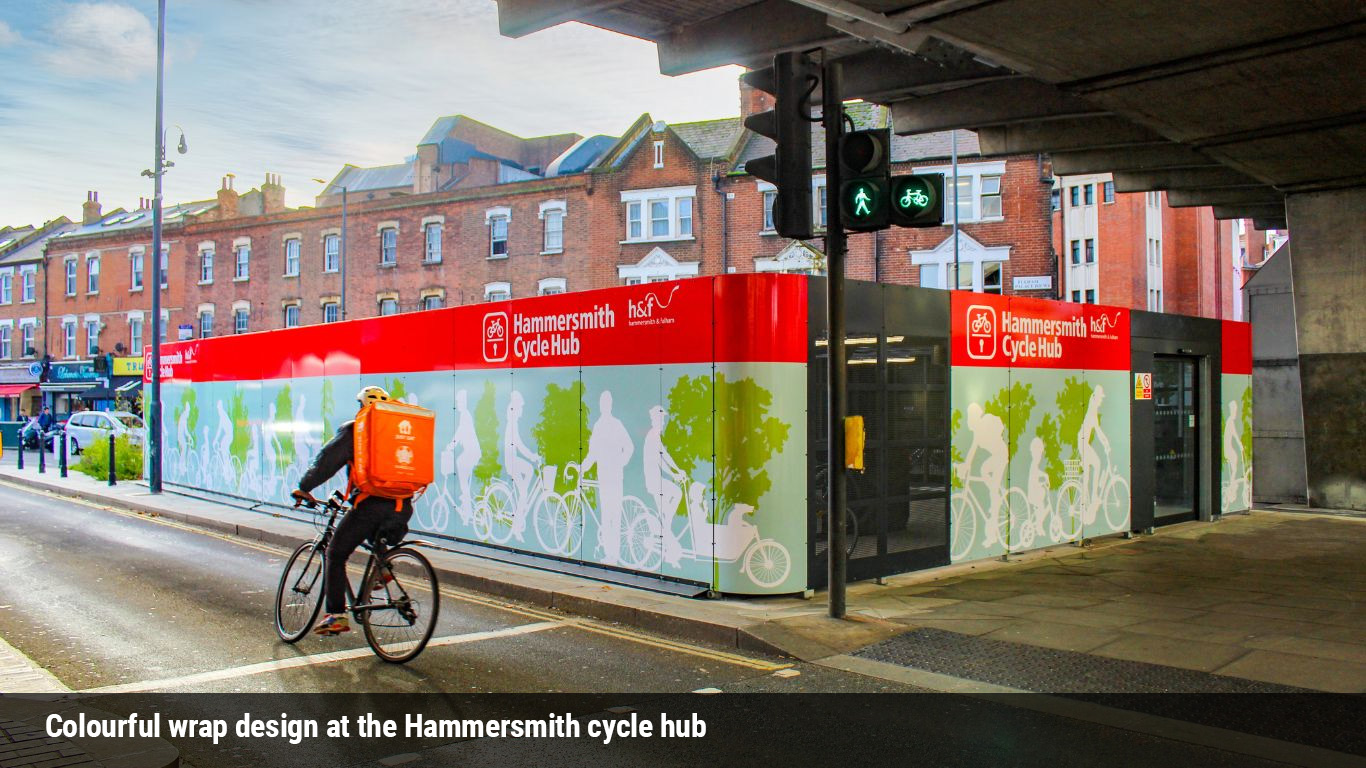How to deliver a successful cycle hub project

Increasing cycle use is a key objective for local authorities, public sector organisations, educational institutions, and many large employers—and for good reason. Encouraging employees, customers, and other visitors to cycle to the site instead of driving can play a significant role in reducing the carbon footprint associated with the site's operations.
But there are other key benefits too, not least that more cycle use can improve air quality locally and lower congestion levels on the local road network. Cycling also increases people’s levels of physical activity, which means the more that people use their bikes, the more they are following a healthier lifestyle. This can only be a good thing for our entire society in terms of reducing the number of people suffering from health issues resulting from inactivity.
All this adds up to cycling being key to making our built environment more sustainable.
However, the best practice approach to creating the facilities and infrastructure on a given site to support the goal of increased cycling will depend on a number of factors, starting with the anticipated number of bikes that need accommodating. This fundamental objective will determine the what type of bike parking and storage is most appropriate on any site.

Choosing the Right Approach: Shelter or hub?
Cycle hubs are undoubtedly the most comprehensive form of storage. They are so much more than simply a large cycle shelter – they are effectively a self-contained building, offering fully enclosed bike racks and other facilities in a secure environment that is protected from the elements.
However, cycle hubs may not be feasible for all projects given the cost and development timescale involved. If the objective is to provide facilities up to around 40 bikes, in most cases the recommended cycle storage approach would be to install sheltered bike racks. This is not to say that a cycle hub would not provide a high quality facility at sites where cycle usage will be at relatively low levels – it just means the return on investment may not be as great.
If, however, you are unsure whether a cycle hub would be right for your premises, this article may help shape your decision and inform your design and specification should you choose to develop such a facility.
Feasibility and strategy for users
A first consideration should be how feasible the project is. Will a cycle hub actually help your organisation achieve its objectives, whether that is to get more employees active, ease pressure on limited car parking spaces, reduce congestion or lower overall emissions for the site operations.
Another question here is whether the budget available is sufficient to create a hub that will be fit for purpose. Cutting corners to accommodate a limited budget may result in a facility that is unpopular with users and, therefore, does not achieve its usage targets. If budget is tight, shelters or canopies complete with cycle racks, cycle pods or other forms of parking may provide an altogether better solution.
And how will cyclists use the cycle hub? Will it be a subscription-based facility where users pay a monthly fee and in return get a swipe card, app or pin to use the hub? Or will it be linked to another form of identity card, such as staff ID badges? Using the hub must be straightforward to maximise engagement and user satisfaction, as well as affordable where a charges will need to apply.
Location, size and foundations
Does the site have space for a cycle hub? They can be relatively large buildings as a recent project completed by Bailey Street Furniture Group (BSFG) at Bournemouth University illustrates. The cycle hub created here measures 10m x 23m and stands at 3m tall, so it is important to understand the potential scale of such a project. But the hub must also be in a convenient location that does not add complexity or cost to its construction.
Andrew Huntley, Business Development Manager at BSFG is a specialist in cycle hubs. He explains:
“We have probably provided more cycle hubs than any other company in recent years. One thing we always highlight at the outset is how crucial it is to thoroughly assess the suitability of the proposed hub location. Put it in the wrong place and people simply won’t use it and that could be an enormous waste of resources.
“We also need to consider the logistics of building it. How easy is it for delivery vehicles to provide materials such as concrete to form the foundations, and a comprehensive site survey will need to be undertaken to identify potential issues such as those resulting from trees, drains and hidden services.
“Remember too that the structure size will often be big, and this means structural calculations and proper foundations will be required. This usually means the laying of a new level concrete base. A structural engineer will need to be consulted and we will always create the hub in accordance with their recommendations as it will need to withstand a 1 in a 100 year storm.”
The design and specification of the foundations will depend on the size of the hub and its capacity as well as its features. For example, cycle hubs which include a sedum roof to meet sustainability goals will be heavier than those with standard roofs.
Security and safety
One of the key benefits of cycle hubs is the enhanced security and safety they offer versus cycle shelters and racks. A variety of access control systems are available, including a system which uses an electronic fob, a swipe card control or linked to a mobile phone app. BSFG even offers an entry system that is compliant with ITSO – the smart ticketing cards in use by 120 UK authorities, including the Key Card used by Southern Rail and Southeastern Rail.

The type of entry system to deploy will depend on the type of users, such as members of the public, registered students or employees, and the level of security sought. And levels of security could be varied in different areas of the cycle hub to offer both secure and open spaces, as was the case in the BSFG project completed at Whittlesford Parkway Station.
It is also important to remember that secure access must be balanced with means of escape, which is why cycle hub design best practice is to incorporate an emergency exit via a second door.
Lighting and accessibility
The security and safety strategy will also consider the design and configuration of the electricity supply and lighting. The hub will need to be well-lit to ensure cyclists can still fully utilise the facility in the evenings and early mornings, and to maintain good visibility as security and personal safety measures.
The hub can also be designed to incorporate CCTV, further boosting peace of mind for users, and a powered door – sliding or hinged – to make it easier to get in and out. In addition, with the rise in e-bike usage, it may also be appropriate to ensure the electrical network can accommodate charging points, if not today in the future.

Meeting user expectations with high quality facilities
As cycle hubs are secure, enclosed buildings, there is greater scope to include bike accessories that optimise the user experience and, hence, maximise user satisfaction. Amongst the options for boosting the facilities available from BSFG are Pump and Repair Stands, Kit Lockers, Benches, Bike Stands for larger bikes including cargo bikes and adapted, plus lockers for Folding bikes. Many of these additional facilities were included within the Windsor Leisure Centre cycle hub, developed by BSFG in 2024.
Cycle hub users will also be more satisfied with the facility if the availability of parking spaces is good. One of the ways the number of spaces can be maximised is by using two tier bike racks.
When specifying a two-tier rack, however, it is important to recognise the variability in quality between different systems and how this contributes to cycle hub users getting the best experience. This is why BSFG recommends the market-leading Easylift Premium system, a two-tier rack that is designed to be lightweight and easy to use, whilst also highly durable to minimise maintenance requirements over a long lifespan.
Aesthetics and materials
The appearance and form of cycle hubs is another important factor. The creative potential is virtually unlimited, with BSFG offering many different timber and aluminium cladding options along with glass which can be combined to achieve the desired look.
A vinyl wrap can also be applied to all or part of the exterior to make the cycle hub more visible or consistent with the rest of the site, such as by carrying branding. This can even be changed at regular intervals to renew a message or offer a fresh aesthetic.
An excellent example of vinyl wraps is at the Hammersmith cycle hub created by BSFG in 2023. This provides over 80 cycle parking spaces as well as additional bays for larger cargo bikes in a highly secure environment. Its profile is maximised through a bright, colourful wrap designed to attract users.
The level of security sought may also be a determining factor for materials. For example, the glass used by BSFG for cycle hubs is 11mm thick, toughened and laminated to offer additional resistance to break-ins or vandalism.
Sustainability
Cycle hubs can also play a meaningful role in supporting broader sustainability goals. In addition to encouraging low-carbon travel, the choice of materials and thoughtful design features can further enhance their environmental credentials.

Green roofs, such as the one installed at Bournemouth University, support biodiversity and help mitigate the environmental impact of new developments.
Roofs can also be fitted with solar panels to generate renewable energy for the hub’s operations such as LED lighting to ensure safe, well-lit access for cyclists around the clock.
Find out more
To discuss any aspect of cycle hub design, construction and operation, please contact the BSFG team on 01625 322 888 or email enquiries@bsfg.co.uk


